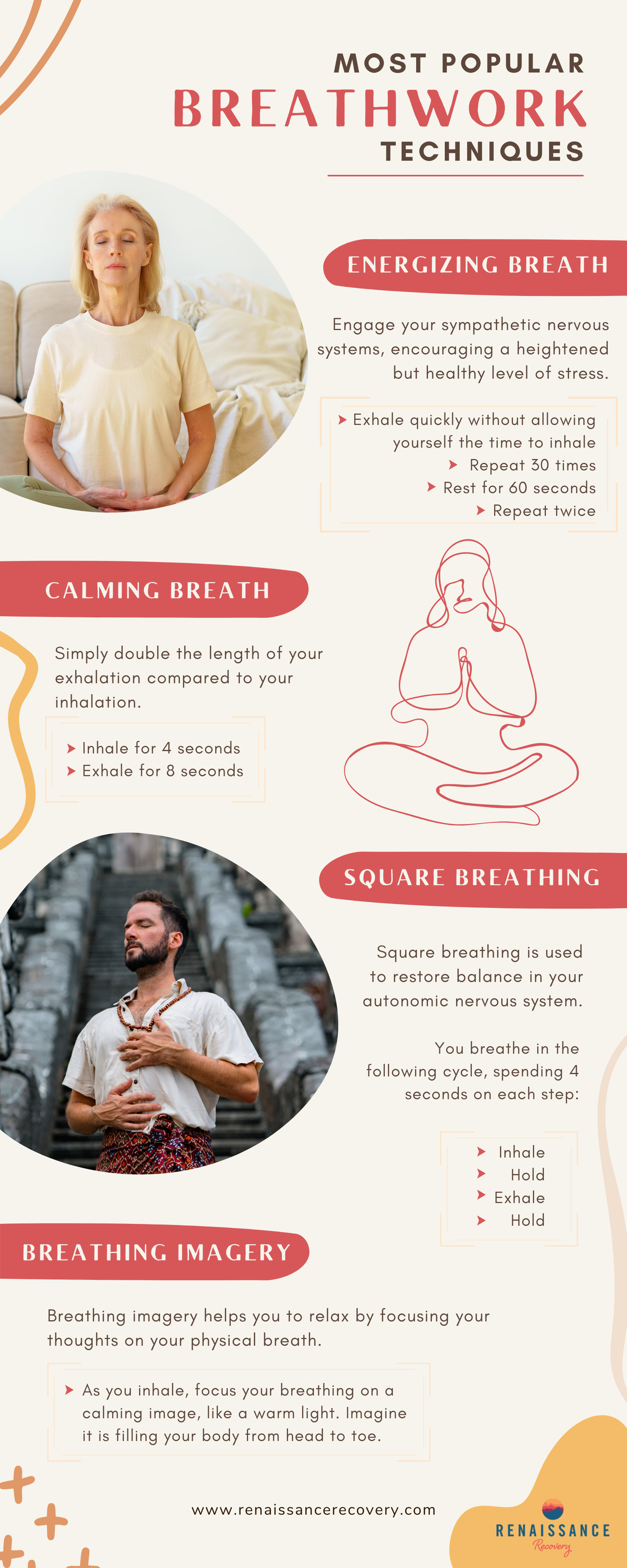What Is Breathwork?
Breathwork is a term used to describe any kind of controlled breathing exercise or breathing technique that is often used for mental health treatment purposes.
There are many different breathing techniques, exercises, and programs that exist inside the umbrella term “breathwork”. While all forms differ slightly, all types of breathwork can help you to consciously focus on inhaling and exhaling while performing deep breaths and focused controlled breathing.
While breathwork might be fashionable right now, the practice is not new. People have been performing breathwork for thousands of years and it is central to yoga.
People perform breathwork to improve their physical, mental, and spiritual well-being. Breathwork penetrated popular culture in 2020 with a Netflix wellness series, The Goop Lab, devoting an episode to The Wim Hof Method.
Breathwork can be effective in alleviating symptoms of the following conditions:
- Chronic pain
- Depression
- Anxiety
- Anger management issues
- Grief
- Trauma
- PTSD (post-traumatic stress disorder)
- Emotional effects of physical illness
It is also a tool used during addiction treatment to help improve mental health and reduce risk of relapse. Before we look into the specifics of breathwork, it is important to understand that if you or a loved one is struggling with substance abuse to reach out to our California rehab today for immediate help.
Breathwork Therapy for Addiction Recovery
Breathwork therapy is also a tool used during addiction treatment to help improve mental health and reduce risk of relapse. Before we look into the specifics of breathwork, it is important to understand that if you or a loved one is struggling with substance abuse to reach out to our California rehab today for immediate help.
You can choose to engage with many types of breathwork therapy. All involve intentionally changing your breathing pattern, breathing in a systematic and conscious way. Many practitioners of breathwork find it encourages a state of deep relaxation. Others practice breathwork to feel more energized and improve mental health.
How Does Breathwork Work?
The premise of breathwork is to nourish your body and mind as you inhale while releasing stress and toxins as you exhale.
Breathing is a core component of most forms of meditation, but breathwork and meditation are not the same. Rather, breathwork is an active meditation technique. Breathwork can deliver both immediate and cumulative benefits.

Breathwork Meditation Techniques
There are hundreds of schools of breathwork and many types of breathing types and techniques within those schools. The healing mechanism in all cases is the mind-body connection. Breathwork is proven effective for promoting relaxation through your body’s innate stress-countering mechanism.
Some of the most common approaches to breathwork include:
- Holotropic breathwork
- Transformational breathwork
- Shamanic breathwork
- Clarity breathwork
- Rebirthing therapy
You can also find focused breathwork exercises in many mindfulness apps.
Breathwork techniques are intended to calm you, energize you, or deliver a balance of calming and energizing while being in the present moment.
How does breathwork manage to achieve this?
The techniques used to appeal to either of these nervous systems:
- Sympathetic nervous system: This is the activating part of the CNS, more active when you exhale.
- Parasympathetic nervous system: This is the calming part of the CNS, more active when you inhale.
Why Is Breathwork Important?
You may be wondering, “why is breathwork important?”. For some, breathwork therapy may sound like a trivial practice. After all, isn’t it just… breathing?
The truth is, there are many scientific studies that show evidence that breathwork relieves symptoms of stress, anxiety, depression, anger, and confusion, as well as helping to regulate your emotions and induce a peaceful state.
The long-term practice of breathwork also helps foster self-awareness, physical well-being, mental clarity, and improved self-image. Breathwork can also help significantly with pain management, digestion, sleep, and the trickle-down effects of reduced stress in the body.
Besides just physical and mental, breathwork can also be a great means for spiritual growth. By altering your state of consciousness, you can begin to get a better perspective on life, your relationships, and yourself.
Types of Breathwork
There are many types of breathwork to choose from, creating a great opportunity for you to customize your practice to your own preferences and needs. It’s generally recommended to start your practice under the guidance of a qualified instructor, especially when dealing with more advanced or intense methods.
These are some of the most popular breathwork exercises:
- Energizing breath
- Calming breath
- Square breathing
- Breathing imagery

Energizing breath
With this breathing exercise, you’ll engage your sympathetic nervous system, encouraging a heightened but healthy level of stress.
Here are two methods of performing energizing breath:
- Exhale too quickly without allowing yourself the time to inhale
- Repeat 30 times
- Rest for 60 seconds
- Repeat twice
Alternatively:
- Inhale faster than usual 20 times
- Release all the air on the final exhale
- Hold your breath for 30 seconds
If you start to perform these breathing exercises when you feel sluggish, this can generate more positive effects than grabbing a cup of coffee.
Calming breath
To perform this breathwork technique, simply double the length of your exhalation compared to your inhalation.
Square breathing
Square breathing exercises are used to restore balance in your autonomic nervous system.
You breathe in the following cycle, spending 4 seconds on each step:
- Inhale
- Hold
- Exhale
- Hold
Breathing Imagery
Breathing imagery can help if you struggle with insomnia. Rather than catastrophizing – worrying about things you cannot control – breathing imagery helps you to relax by focusing your thoughts on your physical breath.
Always speak to your healthcare provider before undertaking any breathwork therapies, especially if you have an underlying medical condition or you are taking any medications.
Holotropic Breathwork
Holotropic breathwork is a specific breathing technique intended for mental health and to encourage emotional coping and personal growth.
Established by Dr. Stan Grof and Christina, his wife, holotropic breathwork is proven effective for heightening awareness.
The goal of holotropic breathwork is to improve your well-being, physical, psychological, and spiritual.
A certified practitioner will lead group sessions instructing you to breathe at a rapid rate for a set period while fully lateral. This can alter your state of consciousness.
Music is a component of holotropic breathwork sessions. After the session, you may have a group discussion and guided drawing.
Transformational Breathwork
The Transformational Breath theory was developed by Dr. Judith Kravitz.
Combining conscious breathing techniques with spiritual and healing concepts, you will be encouraged to breathe deeply, using your full diaphragm. The intention is to unlock wisdom from deep within, allowing you to access the part of you that feels passionate about life.
If you practice this technique, you will learn to inhale deeply through your mouth while expanding your abdomen. As you exhale, you sigh gently.
Although not a miracle cure, the Transformational Breath theory can help in the following ways:
- Reduce stress
- Sharpen immune response
- Improve mental clarity
- Increase oxygen supply
This form of breathwork can help you address physical issues like headaches or asthma. It can also be an effective supplementary form of addiction treatment.

The Benefits of Breathwork
The benefits of breathwork are vast, positively impacting your physical, mental, and emotional well-being. Breathwork therapy can help significantly with many types of ailments and distress, particularly with achieving a peaceful mind.
The benefits of breathwork can vary by individual, but overall share common advantages across all walks of life and skill levels.
People attend breathwork classes for many reasons, including:
- Reducing stress
- Releasing negative thoughts
- Boosting immunity
- Aiding self-development
- Developing life skills
- Enriching creativity
- Healing emotional pain
- Processing trauma
- Dealing with difficult emotions
- Increasing self-awareness
- Improving professional and personal relationships
- Boosting self-confidence
- Overcoming addictions
The benefits of breathwork include:
- Strengthening respiratory function
- Promoting deep sleep
- Reducing feelings of trauma
- Balancing blood pressure
- Improving immune system
- Releasing stress hormones from the body
- Alleviating feelings of anxiety and depression
- Sharpening mental focus
- Decreasing addictive behaviors
- Alkalizing blood pH
- Delivering an anti-inflammatory effect
Beyond this, breathwork can also positively impact your CNS (central nervous system). If you are feeling stressed, you often start taking fast, shallow breaths. Doing this limits the amount of oxygen entering your bloodstream, triggering the fight-or-flight response. If you slow down, purposefully breathing deeply and slowly, your brain tells your body that it is safe to relax, reducing the fight or flight response.

Breathwork at Renaissance Recovery
If you have been struggling with addiction or mental health issues, we can help you address the psychological aspect as well as any issues of physical dependence here at Renaissance Recovery’s Orange County rehab.
You can benefit from holistic therapies like breathwork and meditation alongside an evidence-based array of treatments, including:
- MAT (medication-assisted treatment)
- Psychotherapy (CBT and DBT)
- Individual counseling
- Group counseling
- Family therapy
Here at Renaissance, we specialize in the outpatient treatment of addictions, mental health conditions, and co-occurring disorders. We provide programs at all levels of intensity on the continuum of care, up to and including partial hospitalization programs.
Recovery is an ongoing process, not an event like detox or discharge. At Renaissance, your treatment team will ensure you have a robust aftercare and relapse management strategy in place, maximizing your chances of sustained recovery.
Reach out to Renaissance today to kickstart your recovery by calling our addiction hotline at 866.330.9449.
What is Breathwork? FAQs
What happens during breathwork?
During breathwork, participants engage in intentional breathing techniques that focus on deep, conscious inhalations and exhalations. This practice aims to increase oxygen flow, activate the parasympathetic nervous system, and promote relaxation. Different breathwork modalities can have varying effects, but common experiences include heightened awareness, a release of tension or emotional blockages, a sense of clarity, and a deep state of relaxation or altered consciousness. It is important to approach breathwork with proper guidance and in a safe environment.
Are there any dangers to breathwork?
While breathwork can be a beneficial practice for many individuals, it is important to approach it with caution and under proper guidance. Some potential risks associated with breathwork include hyperventilation, dizziness, lightheadedness, and emotional overwhelm. People with certain medical conditions such as asthma, respiratory issues, or cardiovascular problems should consult with a healthcare professional before engaging in breathwork. It is crucial to learn and practice breathing exercises from qualified instructors who can provide guidance and ensure safety during the process.
How do you perform breathwork?
To perform breathwork, find a comfortable position, either sitting or lying down. Inhale slowly, deep breaths in through your nose, allowing your belly to expand fully, and then exhale slowly through your mouth. Focus on your breath, maintaining a steady rhythm. Some slow-breathing breathwork practices involve specific techniques, such as alternate nostril breathing or rhythmic patterns and belly breathing. It is recommended to learn breathwork from qualified instructors who can guide you through different techniques and ensure you are practicing safely and effectively.
Why is breathwork so powerful?
Breathwork is powerful as it directly influences the body and mind, regulating the nervous system and inducing relaxation. It allows us to access deeper states of consciousness, enhancing self-awareness and emotional connection. With its simplicity and accessibility, breathwork empowers individuals to improve physical vitality and cultivate balance, clarity, and resilience.









